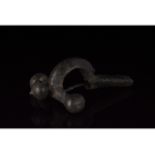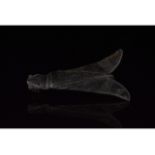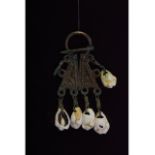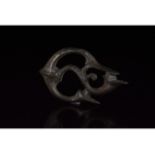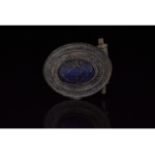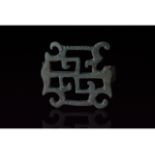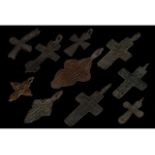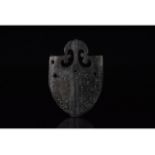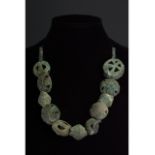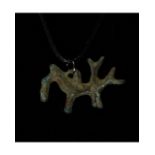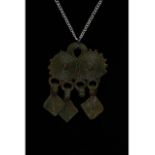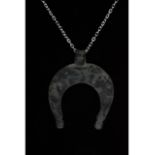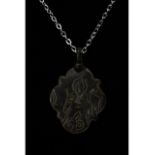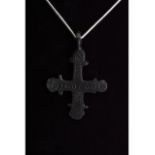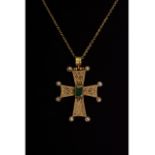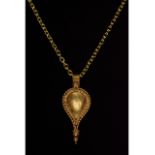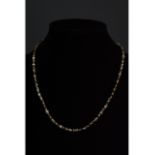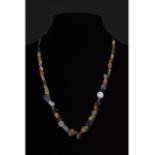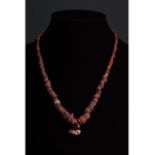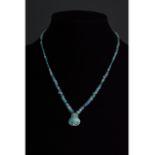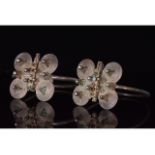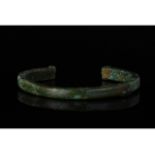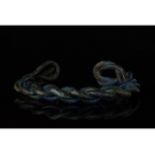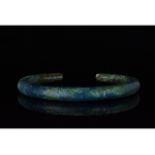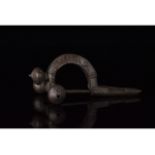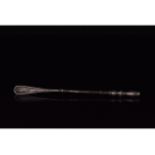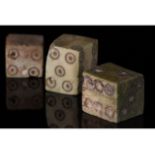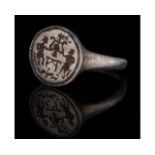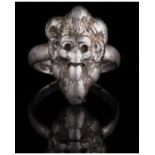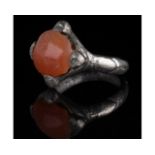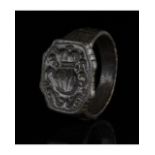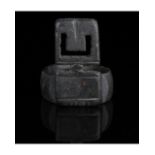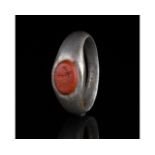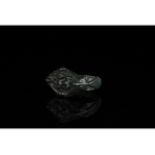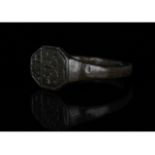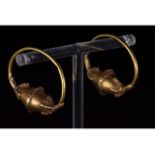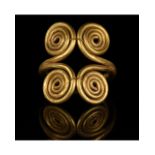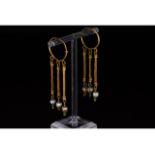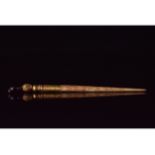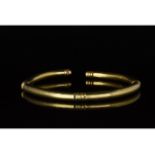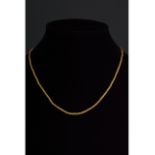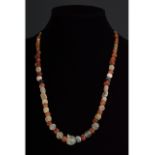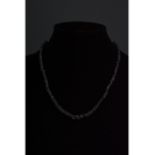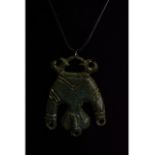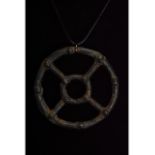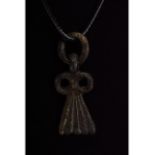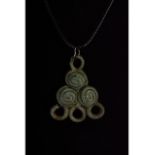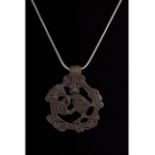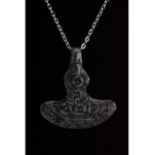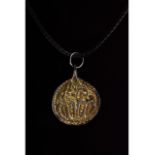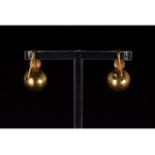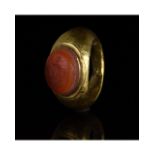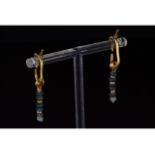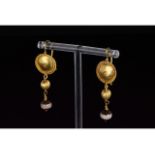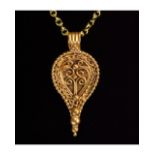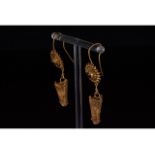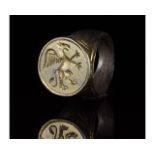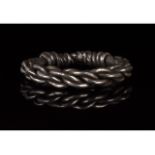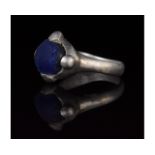Refine your search
Estimate
Category
- Arms, Armour & Militaria (123)
- Jewellery (85)
- Greek, Roman, Egyptian & Other Antiquities (43)
- Sculpture (26)
- Collectables (21)
- Glassware (16)
- Ceramics (5)
- Coins (5)
- Metalware (5)
- Chinese Works of Art (4)
- Vintage Fashion (4)
- Textiles (3)
- Wines & Spirits (3)
- Islamic Works of Art (2)
- Musical Instruments & Memorabilia (2)
- Salvage & Architectural Antiques (2)
- Taxidermy & Natural History (2)
- Tools (2)
- Lighting (1)
- Models, Toys, Dolls & Games (1)
- Scientific Instruments (1)
Filtered by:
- Item Type
- List
- Grid
A subscription to the Price Guide is required to view results for auctions ten days or older. Click here for more information
ROMAN LEGIONARY CROSSBOW BROOCH
300-400 AD. Late Roman. An excellent bronze crossbow brooch, with three onion-like knobs, an arched bow, ribbed lower end and surviving pin. Some ...
LARGE ROMAN BRONZE CIKADA BROOCH
C. 100-200 AD, Roman. Bronze amulet in the form of a fly or cicada, with broad, curving wings, bulging eyes and a triangular head. The catch plate...
Ca. 700-1100 AD. Viking Era. A Viking era bronze omega brooch with flaring terminals decorated with raised dots arranged in geometric patterns, ci...
ROMANO-CELTIC BRONZE BROOCH
c. 100 AD. Roman-Celtic. Bronze openwork brooch featuring three “trumpet” terminals is a form of brooch, as is indicated by the still-preserved ca...
c. 100-300 AD. Roman. Bronze brooch comprising a disk with three raised concentric circles; the flat fields between the raised circles are filled ...
c. 100-300 AD. Roman. Bronze openwork swastika brooch with well-preserved catch-plate on the reverse (the pin does not survive). The swastika was ...
C. 1200 - 1800 AD. Medieval and post-Medieval. A beautiful collection of 10 cross pendants including bronze and iron examples, all of which are ca...
c. 100 AD. Roman-Celtic. Two bronze openwork objects. The object on the right, which features an oval form and vegetal motifs is a harness fitting...
C. 100-300 AD. Roman. Bronze scabbard chape (or bottom) with U-shaped body, openwork pelta ornament and projecting pelta ornament at the top. The ...
Ca.800 - 600 BC. An early necklace formed of bronze pendants in a variety of shapes including bells and spheres (restrung). Bells had magical impl...
Ca. 300 BC. Celtic. Bronze zoomorphic amulet in the shape of an abstract stag with prominent antlers and a suspension loop on its back. The stag w...
Ca.800 BC, Bronze Age. A beautiful Celtic bronze pendant formed as an omega-shaped plaque of round-section wire with coiled ends. The outermost ed...
LARGE ROMAN BRONZE LUNAR AMULET
Ca. 100 AD, Roman. Bronze lunar amulet comprising a crescent moon with a suspension loop, and linearally decorated, rounded terminals. In Roman my...
c. 1000 AD. Byzantine. Scalloped bronze medallion forming a vestigial cross with short, rounded arms. Incised decoration on the amulet depicts the...
C. 1000-1500 AD, Byzantine. Bronze cross with arms terminating in rondels and large suspension loop. The obverse of the cross features an inscript...
C. 900-1200 AD, Byzantine Crusader. Beautiful gold cross with intricate repeating curvilinear scrollwork decoration and a hinged suspension loop. ...
ROMAN GOLD PENDANT
C. 1-300 AD, Roman. A beautiful gold pendant comprising an inverse tear-drop shaped charm with an integrated suspension loop, applied granulations...
ROMAN AGATE BEADED NECKLACE
Ca. 1-300 AD. Roman. A restrung necklace of Roman and modern beads comprising beautiful semiprecious blue Roman agate beads interspaced with moder...
Ca. 1-300 AD. Roman. A restrung necklace of Roman beads comprising multiple opaque and transparent sub- spherical, tubular and discoid glass, glas...
VIKING PERIOD CORAL NECKLACE
C. 900-1100 AD. Viking Period. A beautiful restrung beaded necklace comprised of coral beads in a variety of styles including disk and spheroid sh...
ROMAN GLASS BEADED NECKLACE
Ca. 1-300 AD. Roman. A restrung necklace of Roman beads comprising multiple opaque and sub- spherical, and discoid a glass and glass-paste beads i...
C. 1200 AD. Byzantine. Pair of medieval silver bracelets each comprising a circular hoop with four ornamental spiral disks and applied spherical b...
ROMAN BRONZE ARMILLA BRACELET
C. 1-300 AD. Roman. A heavy bronze armilla bracelet with rectangular section and sub-elliptical, recurved terminals. Armillae were armband style b...
VIKING BRONZE TWISTED BRACELET
700-1100 AD, Viking Age. A heavy bronze twisted bracelet comprised strands of bronze woven together with looped terminals meant evoke the form of ...
700-900 BC, Bronze Age. A heavy bronze bracelet with a sub-circular section. Excellent condition, beautiful patina. Wearable; Size: L:56mm / W:72m...
300-400 AD. Late Roman. An excellent bronze crossbow brooch, with three onion-like protrusions, an arched bow, lower tail with incised chevron dec...
1-200 AD. Roman. Silver ligula, or spoon, with a deep, teardrop-shaped bowl, a cylindrical shank, and carinated handle. In the Roman world, spoons...
1-200 AD. Roman. A set of three bone dice with carefully carved dot-in-circle pips which are typical of dice of the Roman period. Games involving ...
c. 1200-1600 AD. Medieval. Silver ring with circular hoop and a round bezel. The bezel bears incised decoration in the form of a two soldiers supp...
C. 1500-1700 AD. Post-medieval. A rare silver ring with a circular hoop and applied bezel in the form of a devil’s head, with beaklike mouth, holl...
c. 900-1100 AD. Viking age. Silver ring with a circular hoop, and a lozenge shaped bezel onto which is mounted a large, round carnelian gem. This ...
c. 1200-1600 AD. Medieval. Bronze ring with circular hoop, gently flaring shoulders and an octagonal bezel. The bezel bears incised decoration in ...
ROMAN BRONZE KEY RING
Ca 1-300 AD, Roman. A bronze ring with a thick circular hoop, flattened, rectangular bezel and perpendicular projecting key featuring an openwork ...
1-300 AD, Roman. Silver ring with a D-shaped hoop formed from a thick, flat-sectioned, flaring band bearing a red gem intaglio with an incised roo...
700-1100 AD, Viking Age. Beautiful bronze ring comprised of a D-shaped hoop, flaring shoulders with raised geometric decoration and a lozenge-shap...
VIKING BRONZE MYTHOLOGICAL RING
C. 700-1100. Viking Age. Gilded silver amulet featuring a disc shape with an integral suspension loop. The central section depicts the god Odin gr...
VIKING AGE GOLD TEMPLE EARRINGS
c. 900-1100 AD. A matched pair of Viking gold temple earrings; each a round-section shank with hollow biconical bulb; coiled filigree to the shank...
VIKING COILED GOLD RING
700-1100 AD, Viking Age. A gold coiled ring comprising four coils curving outward leaving an open lozenge shaped frame at the centre of the ring. ...
C. 400 BC. Greek Hellenistic. Pair of stunning gold earrings comprising each comprising a hoop from which are suspended three corded pendants endi...
C. 200-300 AD. Roman. Bone pin with partial gold sleeve, featuring a round section, and a knob terminal surmounted by a garnet. Pins like this ele...
CELTIC LA-TENE GOLD BRACELET
CA. 100 BC; Celtic Iron age gold bracelet formf by a thick gold sheet wrapped around a copper core; with decorative pattarens. Size: 70 x 70 mm / ...
LARGE ROMAN GOLD CHAIN
C. 1-300 AD, Roman. Long golden chanin comprising extremely fine links formed into a faux weave. This beauitful chain probably belonged to a Roman...
Ca. 1-300 AD. Roman. A restrung necklace of Roman beads comprising multiple opaque and transparent sub- spherical, tubular and rectangular glass, ...
ROMAN DARK GLASS BEADED NECKLACE
Ca. 1-300 AD. Roman. A restrung necklace of Roman beads comprising multiple opaqu dark coloured sub-spherical, geometric and disk-shaped and glass...
ROMAN BRONZE PHALLUS AMULET
c. 1-300 AD. Roman. A spectacular bronze pendant comprising a double phallus joined at the testes and decorated with linear incised decoration. Ph...
BRONZE AGE SUN AMULET
C. 600 BC, Bronze Age European. Openwork bronze sun pendant comprising two concentric circles with raised decorative dots at regular intervals joi...
C. 900-1100 AD. Viking Age. Bronze Valkyrie amulet comprising heavy suspension loop, stylised circular arms and abstract draped clothing. In Norse...
BRONZE AGE COILED AMULET
Ca. 800 BC. Bronze Age. Coiled bronze amulet comprising a circular suspension loop from which hangs a pyramid formed from bronze coils, the first ...
c. 900-1100 AD. Viking age. A rare Viking amulet with highly stylised, curvilinear representations of a man and a dragon representing Sigurd slayi...
700-1100 AD, Viking Age. A superb silver example of an axe or Perun amulet comprising a suspension loop and stylised blade with stamped geometric ...
C. 700-1100. Viking Age. Gilded silver amulet featuring a disc shape with an integral suspension loop. The central section depicts the god Odin gr...
ROMAN GOLD EARRINGS - WEARABLE
C. 1-300 AD, Roman. Pair of gold drop earrings each comprising a gold disk from which hangs a gold sphere. These beauitful items probably belonged...
1-200 AD. Roman period. A gold ring comprising a D-shaped hoop and circular, high- stepped, red stone intaglio (probably Carnelian) depicting a st...
C. 1-300 AD, Roman. Pair of gold dangle earrings each comprising an hook from which hangs a strand of glass and gold beads. These beauitful items ...
C. 1-300 AD, Roman. Exquisite pair of gold dangle earrings each comprising a gold disk with applied granulations around the borders and centremost...
ROMAN GOLD FILGREE PENDANT
C. 1-300 AD, Roman. A beautiful gold pendant comprising a tear-drop shaped charm with an integrated suspension loop, applied granulations along th...
C. 300-500 AD, Late Roman. Intricate gold pendant earrings comprising suspension loops supporting rondels with concentric bauble decorations and g...
900-1000 AD, Byzantine. A silver, gilt ring with a circular hoop and a trumpet bezel, bearing an incised depiction of a gryphon within a circular....
700-1100 AD, Viking Age. A superb silver ring comprised of a twisted band with wrapped terminals. This ring was intended to evoke the form of a sn...
ROMAN ERA SILVER RING WITH GEM
C. 1-300 AD, Roman. Silver ring with a circular hoop, and a lozenge shaped bezel onto which is mounted a large, elliptical blue gem. This simple y...

